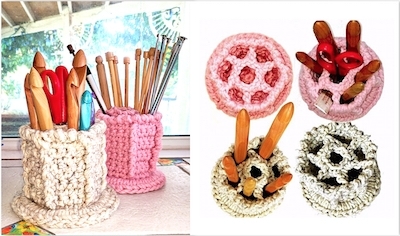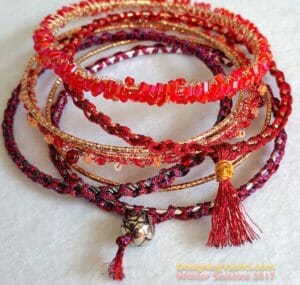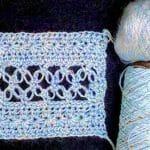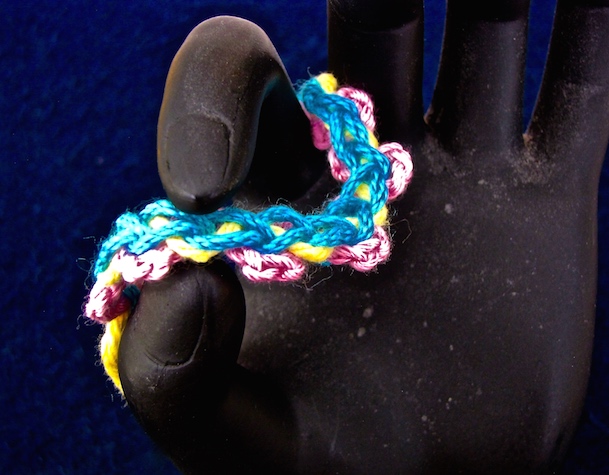
Pictured: Honeycomb-top Big Hook Bucket!
After decades of crocheting and writing about it, I’ve reconsidered the essential character and fundamentals of crochet. I’m an even bigger fan than I already was! Consider what is remarkable about crochet with me:
Why I’d Want to Learn How to Crochet
Easy Control
Terms like easy and simple come up often about crochet. They usually imply not complicated, but I think that’s misleading. What’s easy about crochet is that you have a lot of built-in control. The hook provides it, and the logical structure of one “locked down” loop at a time does it.
Irresistible Rhythm
Crocheting has a wonderfully rejuvenating rhythm. It’s comforting to frayed nerves and reassuring in difficult times. I would want to learn how to crochet just to have this experience.
The Textures Look Complex
The result is a textured fabric that looks more complex than it is. I also appreciate how the inter-looped structure reinforces the material used. It can take the form of diaphanous, seemingly two-dimensional weightless fabrics, a stretchy wind-proof covering, a luxe pearl strand, or a big free-standing figure.
Rapid-Rip
The whole piece is easily “unzipped.” Crocheters call it frogging (because you “rip-it”). The yarn can then be reused, unlike with macramé, for example, which requires you to use several cut pieces instead of one continuous length.
Experience Every Color & Fiber

If I didn’t already know how, I’d want to learn how to crochet just to try crocheting with yarns of different fibers, colors, and thicknesses. It’s a new experience each time. I’m in control of what I spend, too: each crochet project can be as economical or expensive as I want it to be.
I’d say that anything based on manipulating several yards (meters) of stringy stuff will not be easy initially for some folks, but the small challenge is so worth it. Wielding that crochet hook gives you the edge you need to control the yarn while it flows through your fingers at a good rate. It takes just a bit of practice to get up to speed.
As Fast & Portable As Needed
Crochet is as fast, lightweight, and portable as you want it to be. You’re in control there too. No bulky or heavy frames or looms to manage with crochet. Even hairpin lace, a crochet lace technique that uses a type of “loom,” is portable. Most of these mitts were crocheted in one day during a road trip!
I learned how to play the piano, and how to weave, and neither of these was very portable. I’d want to learn how to crochet like some people want to learn guitar: so that they can play anywhere.
Varied & Versatile
Finally, I’d want to learn how to crochet because it adapts to every phase of my life. It’s a distinctly useful, accessible, and versatile construction method. As a child I crocheted things for my sister’s dolls, and for my teachers and friends. As an expectant mother I crocheted things for the baby and to help me wait. I’ve crocheted trendy accessories, toys, Halloween props, protective shields for tech items, educational aids, and the best thing I’ve ever worn to a memorial service.

Historically, crochet developed in several places worldwide. Too bad the specifics of when, and in relation to where, are under-researched and inconclusive.
Given that crochet is a dramatically responsive technique, its development is likely to show marks of time, place, and purpose. For example, doesn’t it seem likely that crochet used in icy climates would develop different stitch patterns, methods, and materials from crochet that developed in tropical climates?
About the Name Crochet
It’s French and means small hook. It’s properly pronounced cro-shay. (Many crochet how-to books don’t give the pronunciation, so I thought I should.) Occasionally I see it spelled crotchet, so perhaps some people pronounce it that way.
All of us English speakers use the French term. In other languages, to crochet is called:
- tejer in Spanish,
- häkeln in German,
- szydelkowac in Polish,
- Gōu biān in Chinese,
- virkning in Swedish,
- hekle in Norwegian, and
- haken in Dutch.
Defining Crochet
Crochet how-to books start out with some kind of introductory description of crochet. I started to write that for this post, then remembered that I did this for the launch of my DesigningVashti.com website! I still like what I wrote there, so please have a look.
Update: In 2018 I suggested this definition of crochet to the Center for Knit and Crochet. As a starting point the group has been using The Getty’s indexing description:
Textile construction involving the interlocking of looped stitches, employing a single cord or strand of yarn and a single hooked needle.
My preference:
Textile construction involving the continual loosening, tightening, wrapping, and interlocking of adjustable loops to form a range of stitch types. A fabric can be built in any direction by adding new stitches anywhere, including “in the air” to add a foundation for new stitches. This freeform property distinguishes crochet from linear grid-based textiles such as weaving (and perhaps nålbinding and knitting). Usually, a single strand of cord or yarn is employed at a time. More than one strand may be held together and used as one, or alternated in use (such as to change colors frequently).
The primary tool is a crochet hook, which resembles a dowel of any diameter with a hook at one end (sometimes at both ends). Stainless steel is the preferred material for the crochet hooks of extremely small diameters (typically 1.75 mm down to .5 mm, for use with superfine threads) for greatest strength and durability. This is probably why the crochet hook may still be referred to with the outdated term “needle”.

